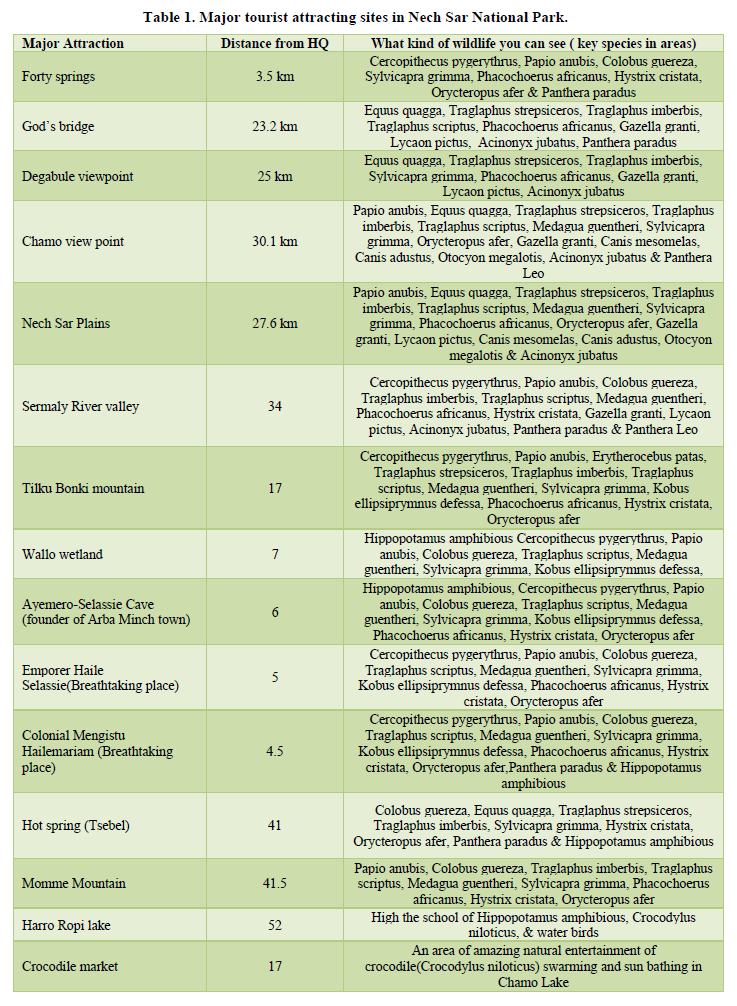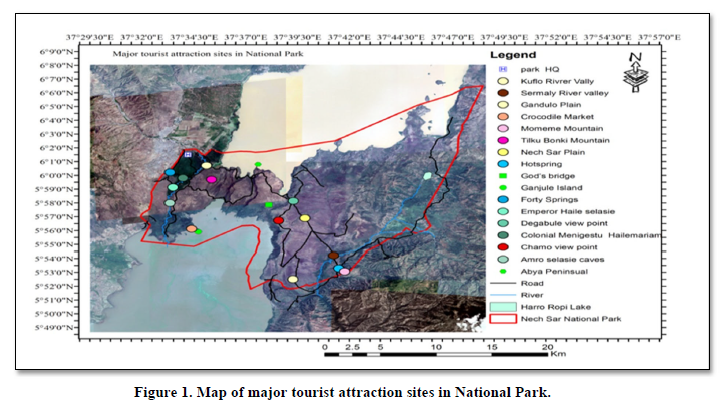4437
Views & Citations3437
Likes & Shares
Keywords: Tourism products, Tourist satisfaction, Tourism animals
METHODS
Sampling design & Technique
The research approaches were following mixed study design that integrates both quantitative and qualitative research methods (Creswell, 2003). Both primary and secondary data were used in this study. The primary data was collected through field observation and questionnaires. GPS based field observations were used to mark core attractions site & Questionnaire were used to investigate tourist satisfaction in the park. Whereas the secondary data was gathered from archives, tourism statistics bulletins and books. For tourism products GPS locations of each destination were recorded Garmin 64 GPS. The representative samples of the respondents were selected purposively. The number of visitors was, 28,490, 862, and 648 for domestic, foreign and foreign residents respectively. Following (Gay, 1996) 5% of the total visitors (n=1,499) was used as sample visitors. Accordingly, the sample size distribution in each visitor was 1,424, 43 & 32 for domestic, foreign and foreign residents respectively. Accordingly, data collected Twelve (12) consecutive Months (July 2021 - June 2022).
Data Collection Methods
Primary and secondary information sources have also been used; the primarily data collection was made using direct observation (personal record) which is supported through Canon digital camera (50*optical zoom & 20.3 mega pixels), 10x42 Binocular and Garmin 64 GPS. On the other hand secondary data were collected from review of relevant different related publications and document reviews. Tourism product data collection a group of the experts and rangers were collaboratively moved to the inside park to explore new and updating old attraction site for the consecutive three months to assess the core tourist potential site. In order to determine the tourism product destination the ground truth points collected via GPS were transferred to QGIS 3.4 software version. The tourist satisfaction data is collected using questionnaire and interview. Questionnaire is very important tool to collect the data from large population. The questions were prepared both in the form of open ended and closed ended questions. In addition, interview was used to collect the data from the respondent. Interview questions also organized in unstructured form and the sequence of questions is not kept during the interview additional questions were raised while conducting the interview in order to get substantiated information for the study.
RESULT AND DISCUSSION
Assessment on Tourism products at Nech Sar National Park was made based on Natural attractions and historical site activities; from the perspective of identifying conservation challenges hindering the management activity and to indorse possible mitigation strategies (Table 1).
Ecological units of the park Vegetation
Nech Sar National Park is endowed with diversity of its riverine and groundwater forest, savanna acacia woodland; open savannah (from which the name of the National Park Nech Sar meaning white grass was derived, as the colour of this open savanna is white), escarpment walls, highland acacia forest, hot springs and lake shores (Figure 1).


In Figure 2 a is Bush land with Ganjullo Island, b is groundwater forest with scattered vegetation with GODs Bridge 3.5km narrowest land b/n the two lakes (Beltae Plain), c is Nech Sar Plain (white grass), d is Lake Chamo with visitors (Source: Tamirat & Teka) filed photo (Figure 2).

BIODIVERSITY
Nech Sar National Park possess more than 103 small & large mammals, 33 Reptiles, 351 Birds, 8 Amphibians, 16 Fish, 21 Snakes, 845 Arthropods, 8 Frog and Toad, 18 Dragonflies flora;- 700-1000 species 6 are endemic similar studies (Clark, 2010). The Swayne’s hartebeests (Alcelaphusbuselaphus swaynii) were introduced to park which are now locally extinct similar studies (Simon et al., 2020) (Figure 3).
Tourist satisfaction status
Majority of National Park visitors were in the level of satisfied. From which 84.5 % of visitors were satisfied, 15.5 % of visitors were highly satisfied (delighted) & No dissatisfied visitor were surveyed; whereas most visitors told us orally, what satisfied them was the abundance of multi attraction in the Park (Figure 4).
Tourists Nationality status
Nech Sar National Park was visiting by foreign visitors, foreign resident visitors & domestic visitors (Figure 5).
Tourists source of information
There are different source of information that enable visitors to get information about the tourist destinations. In 2014 E.C the most of Park visitor’s source of information were friends (friend’s visitors told) (Figure 6).

Tourists Tourism product choices
The charismatic Nech Sar National Park have different attractions that attracted many visitors. Most of Park visitor’s interest was to visit the breathtaking groundwater canopy forest (Figure 7).
Infrastructures challenges for visitors
In Nech Sar National Park one of the biggest tourism development challenge was lack of infrastructure development. Facilities such as Roads across the National Park, Garbage disposal, Outdoor tourist campsite & Eco-friendly toilet didn’t construct in Park (Figure 8).

Tourist Flow & Income Generated Status in 2014 E.C
In 2014 E.C numbers of male visitors were higher than number of female visitors, which were 17,935 & 12,065, respectively. In 2014 E.C total of 30,000 visitors were accommodated at Park, from among about 28,490 were domestic visitors, 862 were foreign visitors & 648 were foreign residents visitors were recorded. National Park was visiting by different visitors & generating income for the country. In 2014 E.C 800,000 Ethiopian Birr has been collected from National Park visitors that were collected from the entrance fee purpose only. Income collected was high on the months of September 103,530 ETB & January 96,045 ETB were collected, whereas relatively to other months of 2014 E.C fewer income was collected on March 26,315 ETB & July 31,555 ETB were collected, respectively (Figures 9 & 10).

Tourist Flow & Income Generated Status from 1987 - 2014 E.C
National Park tourist flows & incomes high before the outbreak of covid-19 pandemic virus. On other hand, unfortunately the emergency of covid-19 damaged the same as the tourist destinations areas. National Park was visiting by domestic visitors, foreign visitors & foreign resident visitors. Comparatively with all years from 1987 E.C up to 2014 E.C number of visitors was highly ordered since on 2008 E.C, 37,570 visitors, 2014 E.C 30,000 visitors were accommodated, respectively. In 2014 E.C income collected was lower than others relatively to its high visitor’s number, because most visitors in 2014 E.C domestic visitors, Because of the entrance fee was less than foreign visitors. May up to August, 2012 E.C tourist flow & revenue collection was zero, due to the occurrence of the pandemic covid-19 virus (Figures 11 & 12).

CONCLUSION AND RECOMMENDATION
This survey is to investigate the potential of tourism products & Visitor satisfactions have been carried out in Nech Sar National Park within 12 months. Currently National Park managed under Ethiopian Wildlife Conservation Authority. The tourism products of Nech Sar National Park are: Ecological units, Biodiversity, & Historical attraction sites. Most visitors are motivated to visit Nech Sar National Park after learning about these areas from tourist information & other sources of information. Visitors’ dissatisfaction in National park are emanated mainly due to; - Limited tourism facilities and infrastructures problems. Based on the findings: Avoid shortage in professional skill among local tour guide, Ethiopia wildlife conservation authority and tourism and cultural minister & non-governmental, Regional & Zonal Culture and Tourism Department & Nech Sar National Park organizations could improve services by investing in the park’s distinctive attributes, promotion and development of tourism products, infrastructure or tourist facility, affective components, and activities to provide natural and relaxation benefits as well as social benefits increasingly sought by park users & Ethiopia government should pay attention to nature and wild animals tourism conservation; nature and wild animals tourism conservation is master key to sustain employment value.
Clark, D. L. (2010). An Introduction to the Natural History of Nech Sar National Park. Ethiopian Wildlife and Natural History Society, Addis Ababa, 45.
Creswell, J. (2003). Research design A qualitative quantitative and mixed method approaches Thousand Oaks CA
Fetene, A., Yeshitela, K., Prasse, R., & Hilker, T. (2013). Study of Changes in Habitat Type Distribution and Habitat Structure of Nech Sar National Park, Ethiopia. Ecologia, 4,1-15.
Gay, L. R. (1986). Educational research competence for Analysis and Application Pearson/cloth bound/672 pp/.
Seid, M., & Kakiso, T. (2019). Critical solutions for critical problems Threats to Sustainable use and Management of Nech Sar National Park NSNP in Ethiopia. African Journal of Hospitality Tourism and Leisure, 8, 1-20.
Simon, S., Karen, V., Jozef, D., & Herwig, L. (2020). (PDF) Human Pressure Threaten Swaynes Hartebeest to Point
Temesgen, F., & Warkineh, B. (2018). Biodiversity Status & Conservation Challenges of Protected Areas of Ethiopia Awash & Nechsar National Parks in Focus. Journal of Natural Sciences Research Www.Iiste.Org ISSN, 8.
Tesema, D., Garbole, D., & Umata, T. (2020). Role of Sustainable Tourism and Ecotourism Development in Ethiopia. Journal of Forestry and Environment, 2, 25-35.
Teshome, E., Ayalew, G., & Workie, A. (2020). Community based ecotourism development in Meqdela Amba, Ethiopia Current development barriers. Journal of Hospitality Management and Tourism, 11,12-20.
Tsegaw, W. E. (2017). Tourist Services Quality Gap Analysis in National Parks of Ethiopia Evidence from Nech Sar National Park. Journal of Tourism & Hospitality, 06(06), 319.
Vreugdenhil, D., Vreugdenhil, A. M., Tilahun, T., Shimelis, A., & Tefera, Z. (2012). GAP analysis of the protected areas system of ethiopia.














